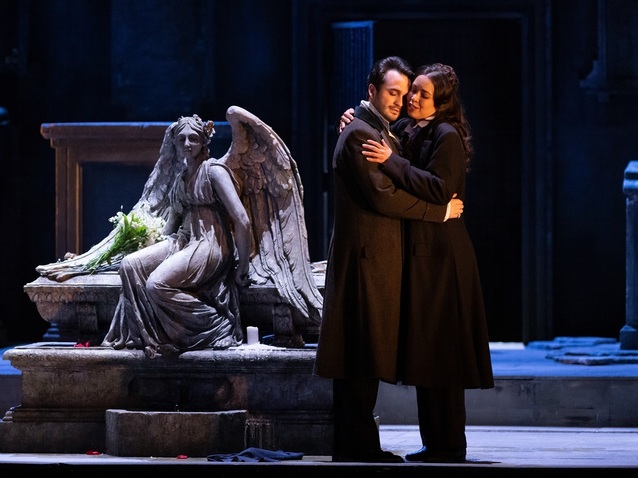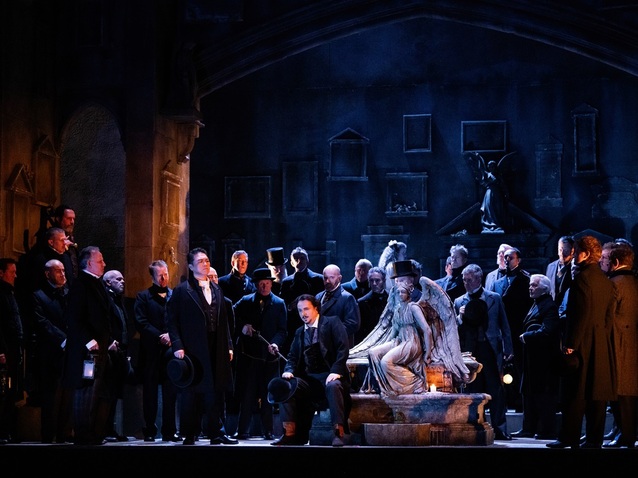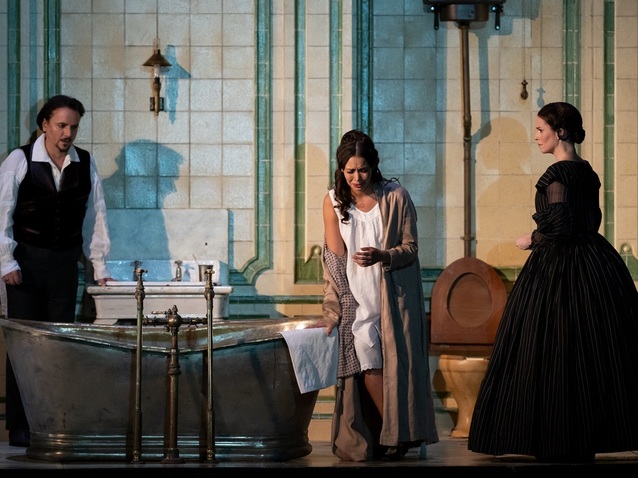 © Camilla Greenwell
© Camilla Greenwell
Based on Sir Walter Scott’s historical novel The Bride of Lammermoor, Donizetti’s Lucia di Lammermoor of 1835, with a libretto by Salvadore Cammarano, is set in Scotland. The Ashton and Ravenswood families have a long-standing hatred of each other with the former family now owning the estate that previously belonged to the latter. The Ashtons have themselves fallen on hard times, however, leading the Master of Lammermoor Enrico to insist that his sister Lucia marry the wealthy Arturo Bucklaw to restore the family’s fortunes.
Lucia, however, has secretly fallen in love with Edgardo from the Ravenswood family, and when Enrico discovers she is in love with the ‘enemy’ he is horrified. He concocts a scheme to make it appear as if Edgardo now loves another woman, which leads Lucia to agree reluctantly to marry Arturo. Following an altercation at the signing of the marriage contract, when Edgardo turns up and confronts Lucia, she goes mad and murders Arturo on their wedding night. Enrico finally appreciates what he put Lucia through when he convinced her of Edgardo’s infidelity and forced her to marry Arturo, but it is too late to save the situation and she dies. On learning of her death, Edgardo commits suicide.
Katie Mitchell’s 2016 staging for the Royal Opera, which represents a co-production with Greek National Opera, does not adhere to the eighteenth century setting of the original story, which occurs around the time of the Act of Union in 1707. In fact, Vicki Mortimer’s sets seem to cross a variety of eras, although they generally centre around the time at which Scott wrote his novel in 1819. Mitchell writes in some extra details, so that we realise within the first few seconds of Act II that the events of Act I, in which Edgardo and Lucia exchanged rings and made their own union, have led to Lucia becoming pregnant.

Lucia de Lammermoor (c) 2024 ROH ph. Camilla Greenwell
For every scene two sets stand alongside each other with the central action occurring on one of them, and the other revealing what is happening simultaneously elsewhere (which in other stagings would not be seen at all). When the production first appeared, the activity in the ‘secondary area’ was often too much and hence distracting. It undermined the significance of several events that normally occur offstage by having them spelt out for us, and marred the emotional impact of certain scenes by removing our focus from the episode that really mattered.
Several revisions, mainly centred on toning down the ‘secondary action’ were made for the first revival in 2017, and the production, revived on this occasion by Robin Tebbutt, has now settled quite well. There are still stronger and weaker aspects to it, meaning one is left feeling that people have had to put much effort into making it work as opposed to designing it well from the outset. There are, however, enough positives to make it feel easy to take the rough with the smooth. For example, splitting the action between two scenes makes the space in which the main activity occurs smaller, and this leads to the chorus standing practically still for the entire signing of the marriage contract scene in Act II as there is no room for them to move. However, Act I benefits from Enrico and then Lucia and Edgardo having a smaller space to fill visually, which heightens the impact of their respective proclamations.
One example of how things were toned down following the production’s first outing comes in Act I’s ‘Sulla tomba che rinserra’. This was originally sung with Lucia and Edgardo partially undressing and indulging in sexual intercourse (although the act was actually rendered very tamely). The difficulty was that the insertion of clear actions to play this out did not make the emotions of the two characters flow naturally, and now the pair remain standing throughout the duet. However, ensuring there is a degree of restraint is not always enough to guarantee success. Mitchell has two ghosts, one of the girl that Edgardo’s ancestor murdered and the other of Lucia’s recently deceased mother, frequently grace the stage. When, however, Lucia’s words, notes and emotions reveal the ghosts she feels around her it seems unnecessary to present them to us, and although they move slowly and silently they can still prove quite distracting. At so many key moments of climax or revelation our attention is shifted away from the music designed to capture these towards the physical presence of one of these figures. For example, placing the ghost of the girl between Lucia and Edgardo towards the end of their Act I scene makes sense symbolically, as it reveals the barriers to their love ever being, but dramatically it destroys the chemistry between the pair in that moment.

(Enrico Ashton) Artur Ruciński (Lucia) Nadine Sierra (Alisa) Rachael Lloyd ROH Lucia di Lammermoor © Camilla Greenwell 2024
In the same way, despite Nadine Sierra putting in a stunning performance in the title role, the impact of the ‘mad scene’ is blunted a little by asking us at times to gaze on her, Edgardo, the ghost of the girl and the ghost of her mother, when we wish to do nothing but focus on Lucia. The direction may be fairly light at this point, but Sierra is still required to interact with these three characters as she sings, which puts a slight emotional check on the proceedings. Were she able to focus solely on feeling the words she espouses, the sense of her being completely lost to madness would be even more overwhelming than it already is.
However, this revival, more than any previous one, allows us to focus on some of the details in the staging, and to appreciate how clever they are. Here, Act I takes place in the (originally) Ravenswood crypt, and as we watch the main action unfold we also see what happens simultaneously in Lucia’s closet back at the Lammermoor Castle. We see her and her companion Alisa (a splendid Rachael Lloyd) dress up as men for her secret rendezvous with Edgardo, and later Enrico invade the room and discover Edgardo’s letters. As Lucia and Edgardo meet, Alisa returns to the closet to find it has been ransacked, which explains why she is subsequently so keen for Lucia to leave Edgardo as she knows they have been ‘rumbled’. There are also other ways in which splitting the scenes adds its own dimensions. The start of Act II represents one occasion when two areas that would naturally be adjacent are presented as it reveals both Lucia’s bedroom and bathroom. This helps to show how Lucia is having to contend with morning sickness at this point, but also how Enrico, in entering her bathroom, is invading her most private space in his efforts to ensure she marries Arturo.
Nadine Sierra is stunning in the title role as her soprano reveals a thrilling combination of richness and sensitivity that makes her coloratura particularly affecting. The spirit of Lucia also comes across clearly, making her character seem highly believable and her descent into madness feel as compelling as it is disturbing to watch. As Edgardo, Xabier Anduaga displays an expansive and ringing tenor, and his performance of Act III’s ‘Tombe degli avi miei’ is quite outstanding. As Enrico, Artur Ruciński is possessed of a full and nuanced baritone, while there is excellent support from Insung Sim as the Calvinist chaplain Raimondo, Andrés Presno as Arturo and Michael Gibson as Enrico’s friend Normanno. Giacomo Sagripanti’s conducting is strong at focusing on the effects that need to be brought out in each scene. Perhaps by the same token, the overall tone does not feel entirely consistent across the evening, but there is no doubting the feelings that it generates in the listener. Several performances over the run see Liv Redpath play Lucia and Ioan Hotea sing Edgardo, while the matinee on 18 May will be conducted by Richard Hetherington.
By Sam Smith
Lucia di Lammermoor | 19 April - 18 May 2024 | Royal Opera House, Covent Garden
the 24 of April, 2024 | Print
Comments